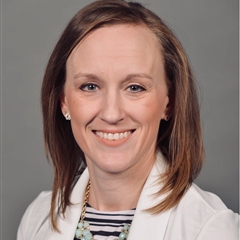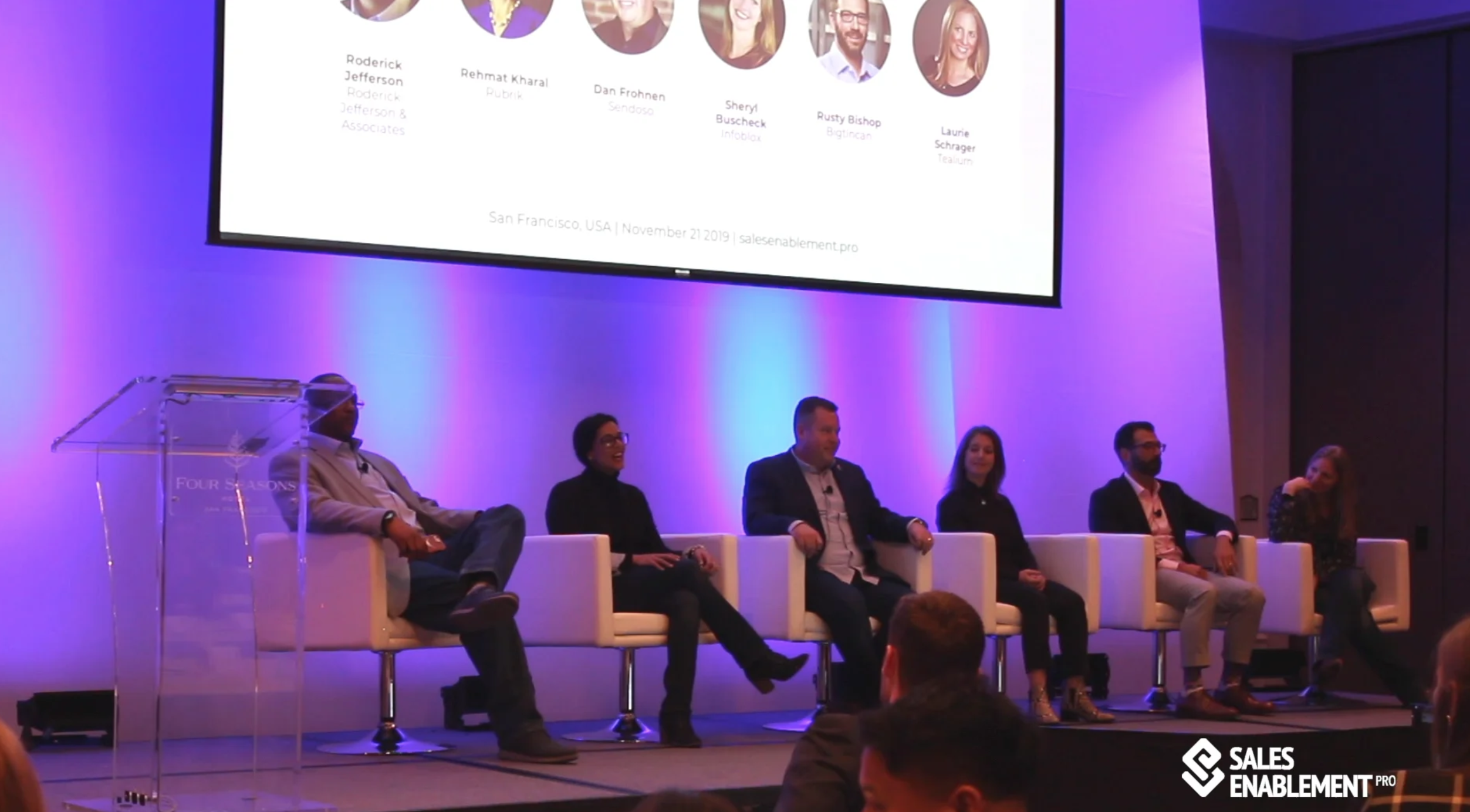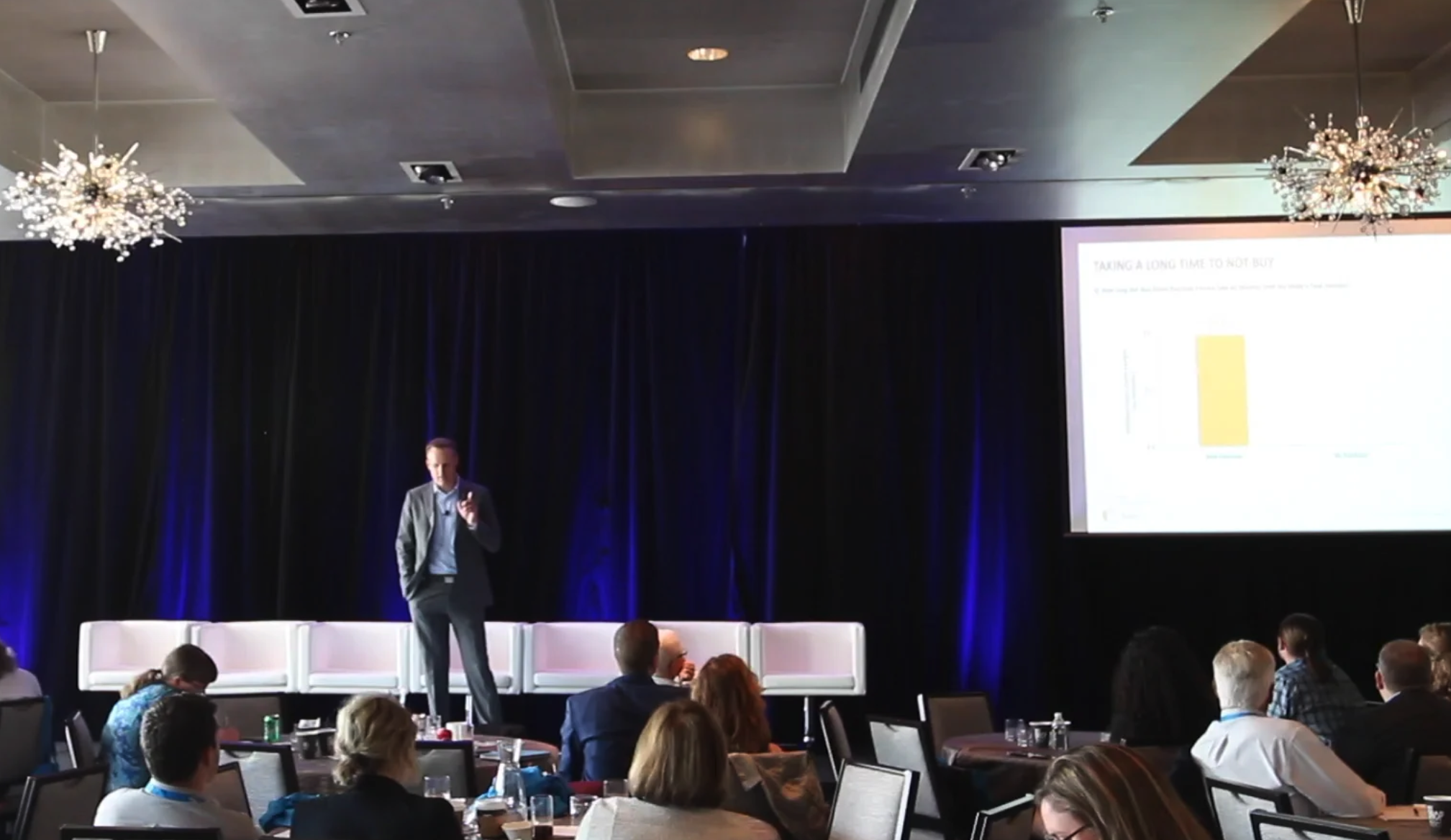Shawnna Sumaoang: Hi, and welcome to the Sales Enablement PRO podcast. I am Shawnna Sumaoang. Sales enablement is a constantly evolving space, and we’re here to help professionals stay up-to-date on the latest trends and best practices so they can be more effective in their jobs.
I would like you guys to just do a brief introduction to you, your role, and if one of you guys could give a brief introduction to Deluxe, that would be great.
Tieg Herman: My name is Tieg Herman and I lead product marketing and sales effectiveness at Deluxe Corporation.
Megan Friedrich: And my name’s Megan Friedrich and I work on our sales effectiveness team at Deluxe Corporation.
SS: I would love to understand what you guys are doing to kind of provide a more holistic view to your sales reps around the buyers, and what they have done to date in their journey with your organization prior to the rep reaching out so that the rep can have those educated conversations.
MF: I think a lot of that starts with our technology and making sure we use our technology to our advantage, and that our marketing teams are very aligned with our sales teams and we’re communicating. We try our best to communicate all marketing campaign activity out to our field so they know when campaigns are going out when a prospect or customer might be getting an email. That’s also tracked in our CRM system so that they can see that and really understand each client and when they’ve been targeted. So, using the technology to make sure we’re clear on our communication.
Then also we really align our marketing story and our campaigns to our buying cycle and to our sales cycle to make sure that we are aligned throughout the sales cycle, that things are lining up depending on where that customer is. And then if they’re getting a campaign pushed, it’s at the right stage in the cycle along with the sales tools that the salesperson might also be pushing out.
TH: Yeah that’s a really good point that I’ll build on. As I put my marketing hat on for a second – as we develop our messaging strategies for a defined period of time, we’ll pull those together and build out our marketing plans which include sales enablement plans. We’ll run those through the general manager of the business, the sales leader of the business, the head product manager for the business, to make sure that everyone’s very clear on exactly what the messaging strategy of the brand is going forward.
That way we really ensure consistency both from that first touch from a demand generation or campaign sampling, all the way through the end of the buyer journey. One-to-one, seller-to-client or prospect, making sure that the message is consistent is really important to us. And then, like Megan said, using technology to help the salesforce understand exactly what’s going out there, to who, and when, and what the message is, is really important.
SS: Absolutely. Thank you both so much. I couldn’t agree more that definitely aligning efforts and enabling across your go-to-market teams to really keep that buyer’s journey holistic, is absolutely a more modern way of doing both marketing and sales within B2B organizations today.
So, I’d like to pivot a little bit. I want to talk about the sales enablement initiatives that you guys have implemented in the past. And the reason is – I’ll give you guys just a little bit more context – what we’ve heard from a lot of other sales enablement practitioners, especially the ones that are getting started, is that they want to understand what the initiatives are that other practitioners are running within their organization that have had the most impact. And just trying to understand from other practitioners, what were those initial pain points that they were feeling? How did they go about coming up with a plan to resolve that? And then, what did implementation, rollout, and the results look like?
So, with that in mind, I would love to talk about maybe some of the initiatives that you guys have done recently. I don’t know if each of you maybe has one that we could talk about, but I would love to understand the most impactful sales initiative to date and why. Tieg, if we could start with you, I would love to do that.
TH: Yeah. We’ve talked a lot about sales process and I would say that that’s definitely one of our most impactful initiatives to date. It’s something that never really stops. We have been working on this for three years and I expect we’ll continue to work on it in perpetuity because the market is always changing. But really, it goes back to what we’ve been talking about which is: how do we make sure that everything that we do aligns with a buyer journey and adds value to our buyers throughout that entire journey.
There are technological components to that. We’ve got to make sure we have sales stages defined the right way. We have to make sure that we develop content to support each of those stages. But the most important thing is – and I guess it’s a bit more philosophical – is how we as an organization approach the market and the perspective that we have as we go into the market to focus less on us and more on our customers. That has been the most important, or one of the most important initiatives that we’ve had in the last several years.
SS: And if I could just ask a follow-on question about that, I would love to know how you guys are measuring the success of those efforts.
TH: Right, yeah. I mean, obviously when you’re looking at was it successful or not, you look at cycle time – did it get shorter? You look at deal size, did it get bigger? And you respond accordingly. So those are some pretty basic things that we look at.
We also look at, as we translate that messaging strategy into marketing campaigns, are we getting traction on those? Are we generating leads based on that same appreciation for the buyer journey? So there are a lot of different ways that we look at it from a quantitative perspective.
We also want to make sure that we are maintaining a really strong connection to the sales force, and getting their feedback. Did this work? Did the buyers appreciate that perspective? Did they get value out of that perspective? And if the answer isn’t yes, then we refine and make sure that we’re always pursuing, creating value for our clients.
SS: I love that. Thank you, Tieg. Megan, could I ask you the same question? I would love to understand from your perspective what the most impactful sales enablement initiative is for you to date?
MF: Yeah, I think one of the biggest projects we’ve done in the last couple of years now is we implemented a new sales enablement platform about two years ago. We had an existing platform, it was not managed probably the best it could have been, so we really took a new look at this and strategically developed and launched a new site to our sales organization.
And we really had a launch plan, we hyped it up, we really wanted to get adoption going from the get-go. Our sales enablement platform encompasses content management, it has our communication system in there, it’s integrated with Salesforce, we also have an LMS tied to it. So really, we wanted it to be kind of that one-stop-shop where they could get anything they needed.
We’ve put a lot of energy not only into putting that site up but constantly making that site relevant. We don’t want it to get stale. We want to make sure the content is up-to-date. We have been launching a lot of new playbooks, and those are really needy documents within our site, that we want new reps to use and we want existing reps to use to learn about a new product. They take a lot of time from our end, also with marketing and product. Because the sales enablement platform is the most visible thing we can produce in sales enablement, we’ve put a lot of energy around that.
And I think we’ve had a lot of really good success. We’re just bringing some new teams onto it this year and I think they’re really excited to use it. Some of these teams have been using SharePoint sites or just their own shared drives, so we’re going from a lot of users that have had a very manual process to now this centralized hub, which is exciting. We’ve also got some sophisticated sellers that have come from different places and we’re getting their feedback and just constantly making that better, and looking at what new technology is out there and never allowing it to get stale.
SS: I love that. If I can actually drill in a little bit into a couple of areas, I would love to understand how you built out the criteria for what it was that you needed when you went out to evaluate sales enablement solutions.
MF: Yes. A couple of years ago when we first initially looked to switch platforms we had an existing site; so we had a good baseline of what we needed. It was basic. It was mostly just content management. We needed to move our sales assets to another site. As we looked at the solutions that were out there, we really immersed ourselves pretty in-depth with what the functionality there is. What do we need? It’s as simple as, “here’s a list of all the functionality – you may not be ready for all that right now.” You need to determine what are the requirements that are relevant to you.
So for us, it was obviously having the content management capabilities. It was having a way to communicate in a centralized communication process. It was being able to sort our content by organizational unit or by function or product team – however, you wanted to get the right content to the right person. Also, it was very important for us to integrate with our CRM. So we made a list of those requirements.
A lot of it also – as Tieg mentioned – was a cool experience of seeing the buying cycle on the buyer’s side. So, we evaluated solutions based on how we interacted with them: are they understanding our problems? Are we able to morph and change over time? As I said, we don’t ever stay stale, so we’re always evaluating what solutions are out there. Where is the market going? It’s changing really fast. The cool thing about sales enablement platforms is that it is technology. It’s changing fast, you need to stay up to speed on it, and there’s a lot of cool features out there, but you need to make sure that it aligns to what you need in your organization.
SS: Absolutely, absolutely. And I think rep satisfaction, as you alluded to earlier, as well as adoption, is absolutely critical with these platforms, as well as finding a partner that can scale with you. So that was excellent, thank you for walking me through that.
One of the other things I wanted to just drill in on – just for a moment if you don’t mind – you mentioned the notion of a sales playbook. I know that there’s a wide variety of types the playbooks that come to mind with sales enablement practitioners. When they think about that the term “sales playbook”, it’s been around for a while. If you go back a couple of decades, it could even invoke an image of a three-ring binder that you give to your reps when they’re on board and, “Here, flip this tab, you have this conversation and then this will tell you how to handle this scenario.” I would love to hear from you guys what you guys are doing with your sales playbook today.
MF: Yeah, just like you mentioned, I remember the times where I created the sales binders and we mailed them out to the teams. So we’ve morphed and changed, and to be honest the term “playbook” sometimes has a negative connotation with our team just because they think it’s something that is printed out and set on their desk and they will say, “I already know how to do my job.”
So, we’ve really looked at it as providing our sales teams with the information that they need at the appropriate sales stage so we really align it to our sales process stages. It’s what do they need to understand about the market and the industry at that point in time? What are some insights that they need to speak to? What are the things, the best practices they need to do or the objections they need to understand at that point in time? And then what else is the content they need to show, whether it’s a white paper or another sales tool? You know, all the way through the sales process.
When you get to the later sales stages and they need to understand the product, they need to know how to talk about the product. So making sure we’re not throwing everything at them at once, but really when they’re at this point in time in a sale stage, this is what they need to know and talk about to their customer.
TH: I think another thing to think about as you think about sales playbooks from 2019 is this content dynamic. When you take the old binder example, a week and a half after your mail it out, half of it is not relevant. I think this is another really important part of the power of the sales portal. It is a source of truth. So, as all that market perspective goes into a sales playbook and as tools that align a sales process go into a sales playbook, we’ve really put a lot of effort into making sure that those are always updated and coaching our sales partners to go to that playbook first rather than downloading items and saving them on their desktop. We are able to make adjustments and updates, enhancements on the fly so that the sales playbook remains really, really dynamic and is always the source of truth for our team. So, that’s a really important part of our focus in creating it.
SS: Thanks for listening! For more insights, tips, and expertise from sales enablement leaders, visit salesenablement.pro. If there’s something you’d like to share or a topic you want to know more about let us know – we’d love to hear from you.








